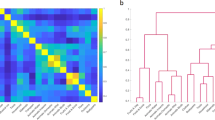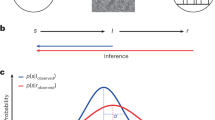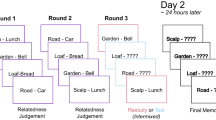Abstract
Correctly identifying the meaning of a stimulus requires activating the appropriate semantic representation among many alternatives. One way to reduce this uncertainty is to differentiate semantic representations from each other, thereby expanding the semantic space. Here, in four experiments, we test this semantic-expansion hypothesis, finding that uncertainty-averse individuals exhibit increasingly differentiated and separated semantic representations. This effect is mirrored at the neural level, where uncertainty aversion predicts greater distances between activity patterns in the left inferior frontal gyrus when reading words, and enhanced sensitivity to the semantic ambiguity of these words in the ventromedial prefrontal cortex. Two direct tests of the behavioural consequences of semantic expansion further reveal that uncertainty-averse individuals exhibit reduced semantic interference and poorer generalization. Together, these findings show that the internal structure of our semantic representations acts as an organizing principle to make the world more identifiable.
This is a preview of subscription content, access via your institution
Access options
Access Nature and 54 other Nature Portfolio journals
Get Nature+, our best-value online-access subscription
$29.99 / 30 days
cancel any time
Subscribe to this journal
Receive 12 digital issues and online access to articles
$119.00 per year
only $9.92 per issue
Buy this article
- Purchase on Springer Link
- Instant access to full article PDF
Prices may be subject to local taxes which are calculated during checkout




Similar content being viewed by others
Data availability
De-identified data for all experiments are publicly available at https://osf.io/gmqh4. The data used for analyses to estimate semantic similarity and ambiguity are available at https://nlp.stanford.edu/projects/glove/ and https://elexicon.wustl.edu/.
Code availability
Codes for the analyses of the paper are publicly available at https://osf.io/gmqh4.
References
Kahneman, D. & Tversky, A. Variants of uncertainty. Cognition 11, 143–157 (1982).
Bach, D. R. & Dolan, R. J. Knowing how much you don’t know: a neural organization of uncertainty estimates. Nat. Rev. Neurosci. 13, 572–586 (2012).
Vives, M. L. & FeldmanHall, O. Tolerance to ambiguous uncertainty predicts prosocial behavior. Nat. Commun. 9, 2156 (2018).
Kahneman, D. & Tversky, A. Prospect theory: an analysis of decision under risk. Econometrica 47, 263 (1979).
FeldmanHall, O. & Shenhav, A. Resolving uncertainty in a social world. Nat. Hum. Behav. 3, 426–435 (2019).
Huettel, S. A., Stowe, C. J., Gordon, E. M., Warner, B. T. & Platt, M. L. Neural signatures of economic preferences for risk and ambiguity. Neuron 49, 765–775 (2006).
Freeston, M. H., Rhéaume, J., Letarte, H., Dugas, M. J. & Ladouceur, R. Why do people worry?. Pers. Individ. Differ. https://doi.org/10.1016/0191-8869(94)90048-5 (1994).
Hirsh, J. B., Mar, R. A. & Peterson, J. B. Psychological entropy: a framework for understanding uncertainty-related anxiety. Psychol. Rev. 119, 304–320 (2012).
Buhr, K. & Dugas, M. J. The intolerance of uncertainty scale: psychometric properties of the English version. Behav. Res. Ther. 40, 931–945 (2002).
Ladouceur, R., Talbot, F. & Dugas, M. J. Behavioral expressions of intolerance of uncertainty in worry: experimental findings. Behav. Modif. 21, 355–371 (1997).
Dugas, M. J. et al. Intolerance of uncertainty and information processing: evidence of biased recall and interpretations. Cogn. Ther. Res. 29, 57–70 (2005).
Luhmann, C. C., Ishida, K. & Hajcak, G. Intolerance of uncertainty and decisions about delayed, probabilistic rewards. Behav. Ther. 42, 378–386 (2011).
Tanovic, E., Gee, D. G. & Joormann, J. Intolerance of uncertainty: neural and psychophysiological correlates of the perception of uncertainty as threatening. Clin. Psychol. Rev. 60, 87–99 (2018).
Gilboa, I. & Schmeidler, D. Maxmin expected utility with non-unique prior. J. Math. Econ. 18, 141–153 (1989).
Van Baar, J. M., Halpern, D. J. & FeldmanHall, O. Intolerance of uncertainty modulates brain-to-brain synchrony during politically polarized perception. Proc. Natl Acad. Sci. USA 118, e2022491118 (2021).
Griffiths, T. L., Steyvers, M. & Tenenbaum, J. B. Topics in semantic representation. Psychol. Rev. 114, 211–244 (2007).
Henderson, J. M. & Hayes, T. R. Meaning-based guidance of attention in scenes as revealed by meaning maps. Nat. Hum. Behav. 1, 743–747 (2017).
Chadwick, M. J. et al. Semantic representations in the temporal pole predict false memories. Proc. Natl Acad. Sci. USA 113, 10180–10185 (2016).
McEvoy, C. L., Nelson, D. L. & Komatsu, T. What is the connection between true and false memories? The differential roles of interitem associations in recall and recognition. J. Exp. Psychol. Learn. Mem. Cogn. 25, 1177–1194 (1999).
Badre, D., Bhandari, A., Keglovits, H. & Kikumoto, A. The dimensionality of neural representations for control. Curr. Opin. Behav. Sci. 38, 20–28 (2021).
Rigotti, M. et al. The importance of mixed selectivity in complex cognitive tasks. Nature 497, 585–590 (2013).
Diedrichsen, J., Wiestler, T. & Ejaz, N. A multivariate method to determine the dimensionality of neural representation from population activity. Neuroimage 76, 225–235 (2013).
Fusi, S., Miller, E. K. & Rigotti, M. Why neurons mix: high dimensionality for higher cognition. Curr. Opin. Neurobiol. 37, 66–74 (2016).
Franconeri, S. L., Alvarez, G. A. & Cavanagh, P. Flexible cognitive resources: competitive content maps for attention and memory. Trends Cogn. Sci. 17, 134–141 (2013).
Landauer, T. K. & Dumais, S. T. A solution to Plato’s problem: the latent semantic analysis theory of acquisition, induction, and representation of knowledge. Psychol. Rev. 104, 211–240 (1997).
Kruskal, J. B. Multidimensional scaling by optimizing goodness of fit to a nonmetric hypothesis. Psychometrika 29, 1–27 (1964).
Friederici, A. D. The brain basis of language processing: from structure to function. Physiol. Rev. 91, 1357–1392 (2011).
Poldrack, R. A. et al. Functional specialization for semantic and phonological processing in the left inferior prefrontal cortex. Neuroimage 10, 15–35 (1999).
Frankland, S. M. & Greene, J. D. Concepts and compositionality: in search of the brain’s language of thought. Annu. Rev. Psychol. 71, 273–303 (2020).
Fedorenko, E., Blank, I. A., Siegelman, M. & Mineroff, Z. Lack of selectivity for syntax relative to word meanings throughout the language network. Cognition 203, 104348 (2020).
Fairhall, S. L. & Caramazza, A. Brain regions that represent amodal conceptual knowledge. J. Neurosci. 33, 10552–10558 (2013).
Hoffman, P., Pobric, G., Drakesmith, M. & Lambon Ralph, M. A. Posterior middle temporal gyrus is involved in verbal and non-verbal semantic cognition: evidence from rTMS. Aphasiology 26, 1119–1130 (2012).
Knecht, S. et al. Language lateralization in healthy right-handers. Brain 123, 74–81 (2000).
Bechara, A., Damasio, H. & Damasio, A. R. Emotion, decision making and the orbitofrontal cortex. Cereb. Cortex 10, 295–307 (2000).
Critchley, H. D., Mathias, C. J. & Dolan, R. J. Neural activity in the human brain relating to uncertainty and arousal during anticipation. Neuron 29, 537–545 (2001).
FeldmanHall, O. et al. Stimulus generalization as a mechanism for learning to trust. Proc. Natl Acad. Sci. USA 115, E1690–E1697 (2018).
Hsu, M., Bhatt, M., Adolphs, R., Tranel, D. & Camerer, C. F. Neural systems responding to degrees of uncertainty in human decision-making. Science 310, 1680–1683 (2005).
Levy, I., Snell, J., Nelson, A. J., Rustichini, A. & Glimcher, P. W. Neural representation of subjective value under risk and ambiguity. J. Neurophysiol. 103, 1036–1047 (2010).
Walther, A. et al. Reliability of dissimilarity measures for multi-voxel pattern analysis. Neuroimage 137, 188–200 (2016).
Fedorenko, E., Duncan, J. & Kanwisher, N. Broad domain generality in focal regions of frontal and parietal cortex. Proc. Natl Acad. Sci. USA 110, 16616–16621 (2013).
Hoffman, P., Lambon Ralph, M. A. & Rogers, T. T. Semantic diversity: a measure of semantic ambiguity based on variability in the contextual usage of words. Behav. Res. Methods 45, 718–730 (2013).
FeldmanHall, O. et al. Stimulus generalization as a mechanism for learning to trust. Proc. Natl Acad. Sci. USA 115, 1690 (2018).
Shepard, R. N. Toward a universal law of generalization for psychological science. Science 237, 1317–1323 (1987).
Rodd, J. M., Gaskell, M. G. & Marslen-Wilson, W. D. Modelling the effects of semantic ambiguity in word recognition. Cogn.Sci. https://doi.org/10.1016/j.cogsci.2003.08.002 (2004).
Roelofs, A. A spreading-activation theory of lemma retrieval in speaking. Cognition 42, 107–142 (1992).
Schnur, T. T. et al. Localizing interference during naming: convergent neuroimaging and neuropsychological evidence for the function of Broca’s area. Proc. Natl Acad. Sci. USA 106, 322–327 (2009).
Vuong, L. C. & Martin, R. C. LIFG-based attentional control and the resolution of lexical ambiguities in sentence context. Brain Lang. 116, 22–32 (2011).
Riès, S. K., Karzmark, C. R., Navarrete, E., Knight, R. T. & Dronkers, N. F. Specifying the role of the left prefrontal cortex in word selection. Brain Lang. 149, 135–147 (2015).
Pino, D., Mädebach, A., Jescheniak, J. D., Regenbrecht, F. & Obrig, H. BONEs not CATs attract DOGs: semantic context effects for picture naming in the lesioned language network. Neuroimage 246, 118767 (2022).
Volz, K. G., Schubotz, R. I. & Von Cramon, D. Y. Predicting events of varying probability: uncertainty investigated by fMRI. Neuroimage 19, 271–280 (2003).
Rushworth, M. F. S. & Behrens, T. E. J. Choice, uncertainty and value in prefrontal and cingulate cortex. Nat. Neurosci. 11, 389–397 (2008).
Philiastides, M. G., Ratcliff, R. & Sajda, P. Neural representation of task difficulty and decision making during perceptual categorization: a timing diagram. J. Neurosci. 26, 8965–8975 (2006).
Grindrod, C. M., Bilenko, N. Y., Myers, E. B. & Blumstein, S. E. The role of the left inferior frontal gyrus in implicit semantic competition and selection: an event-related fMRI study. Brain Res. 1229, 167–178 (2008).
Fedorenko, E. & Blank, I. A. Broca’s area is not a natural kind. Trends Cogn. Sci. 24, 270–284 (2020).
Badre, D. & Wagner, A. D. Left ventrolateral prefrontal cortex and the cognitive control of memory. Neuropsychologia 45, 2883–2901 (2007).
Hoffman, P., McClelland, J. L. & Lambon Ralph, M. A. Concepts, control, and context: a connectionist account of normal and disordered semantic cognition. Psychol. Rev. 125, 293–328 (2018).
Sims, C. R. Efficient coding explains the universal law of generalization in human perception. Science 360, 652–656 (2018).
Shepard, R. N. The analysis of proximities: multidimensional scaling with an unknown distance function. I. Psychometrika 27, 125–140 (1962).
Bangert, M. et al. Shared networks for auditory and motor processing in professional pianists: evidence from fMRI conjunction. Neuroimage 30, 917–926 (2006).
Esteban, O. et al. fMRIPrep: a robust preprocessing pipeline for functional MRI. Nat. Methods 16, 111–116 (2019).
Gorgolewski, K. et al. Nipype: a flexible, lightweight and extensible neuroimaging data processing framework in Python. Front. Neuroinform. 5, 13 (2011).
Tustison, N. J. et al. N4ITK: improved N3 bias correction. IEEE Trans. Med. Imaging 29, 1310–1320 (2010).
Avants, B. B., Epstein, C. L., Grossman, M. & Gee, J. C. Symmetric diffeomorphic image registration with cross-correlation: evaluating automated labeling of elderly and neurodegenerative brain. Med. Image Anal. 12, 26–41 (2008).
Zhang, Y., Brady, M. & Smith, S. Segmentation of brain MR images through a hidden Markov random field model and the expectation–maximization algorithm. IEEE Trans. Med. Imaging 20, 45–57 (2001).
Fonov, V., Evans, A., McKinstry, R., Almli, C. & Collins, D. Unbiased nonlinear average age-appropriate brain templates from birth to adulthood. Neuroimage 47, S102 (2009).
Jenkinson, M. & Smith, S. A global optimisation method for robust affine registration of brain images. Med. Image Anal. 5, 143–156 (2001).
Greve, D. N. & Fischl, B. Accurate and robust brain image alignment using boundary-based registration. Neuroimage 48, 63–72 (2009).
Jenkinson, M., Bannister, P., Brady, M. & Smith, S. Improved optimization for the robust and accurate linear registration and motion correction of brain images. Neuroimage 17, 825–841 (2002).
Cox, R. W. & Hyde, J. S. Software tools for analysis and visualization of fMRI data. NMR Biomed. 10, 171–178 (1997).
Power, J. D. et al. Methods to detect, characterize, and remove motion artifact in resting state fMRI. Neuroimage 84, 320–341 (2014).
Behzadi, Y., Restom, K., Liau, J. & Liu, T. T. A component based noise correction method (CompCor) for BOLD and perfusion based fMRI. Neuroimage 37, 90–101 (2007).
Muschelli, J. et al. Reduction of motion-related artifacts in resting state fMRI using aCompCor. Neuroimage 96, 22–35 (2014).
Satterthwaite, T. D. et al. An improved framework for confound regression and filtering for control of motion artifact in the preprocessing of resting-state functional connectivity data. Neuroimage 64, 240–256 (2013).
Lanczos, C. Evaluation of noisy data. J. Soc. Ind. Appl. Math. B 1, 76–85 (1964).
Tzourio-Mazoyer, N. et al. Automated anatomical labeling of activations in SPM using a macroscopic anatomical parcellation of the MNI MRI single-subject brain. Neuroimage 15, 273–289 (2002).
Nili, H. et al. A toolbox for representational similarity analysis. PLoS Comput. Biol. 10, e1003553 (2014).
Barr, D. J., Levy, R., Scheepers, C. & Tily, H. J. Random effects structure for confirmatory hypothesis testing: keep it maximal. J. Mem. Lang. 68, 255–278 (2013).
Balota, D. A. et al. The English lexicon project. Behav. Res. Methods 39, 445–459 (2007).
Acknowledgements
This work was funded by a Carney Innovation Grant from the Robert J. and Nancy D. Carney Institute for Brain Science and NIH Centers of Biomedical Research Excellence Grant, no. P20GM103645 awarded to O.F.H. A.B. was supported by grant number R01MH125497 from the National Institute of Mental Health and grant number R21NS108380 from the National Institute of Neurological Disorders and Stroke of the National Institutes of Health. The funders had no role in study design, data collection and analysis, decision to publish or preparation of the manuscript.
Author information
Authors and Affiliations
Contributions
M.-L.V., D.d.B., O.F.H. & A.B. contributed to designing the research and writing the paper. J.M.v.B performed data collection. M.-L.V. and D.d.B. performed the data analyses.
Corresponding authors
Ethics declarations
Competing interests
The authors declare no competing interests.
Peer review
Peer review information
Nature Human Behaviour thanks Rebecca Jackson and the other, anonymous, reviewer(s) for their contribution to the peer review of this work.
Additional information
Publisher’s note Springer Nature remains neutral with regard to jurisdictional claims in published maps and institutional affiliations.
Supplementary information
Supplementary Information
Supplementary Figs. 1–4 and Tables 1–4.
Rights and permissions
Springer Nature or its licensor (e.g. a society or other partner) holds exclusive rights to this article under a publishing agreement with the author(s) or other rightsholder(s); author self-archiving of the accepted manuscript version of this article is solely governed by the terms of such publishing agreement and applicable law.
About this article
Cite this article
Vives, ML., de Bruin, D., van Baar, J.M. et al. Uncertainty aversion predicts the neural expansion of semantic representations. Nat Hum Behav 7, 765–775 (2023). https://doi.org/10.1038/s41562-023-01561-5
Received:
Accepted:
Published:
Issue Date:
DOI: https://doi.org/10.1038/s41562-023-01561-5



